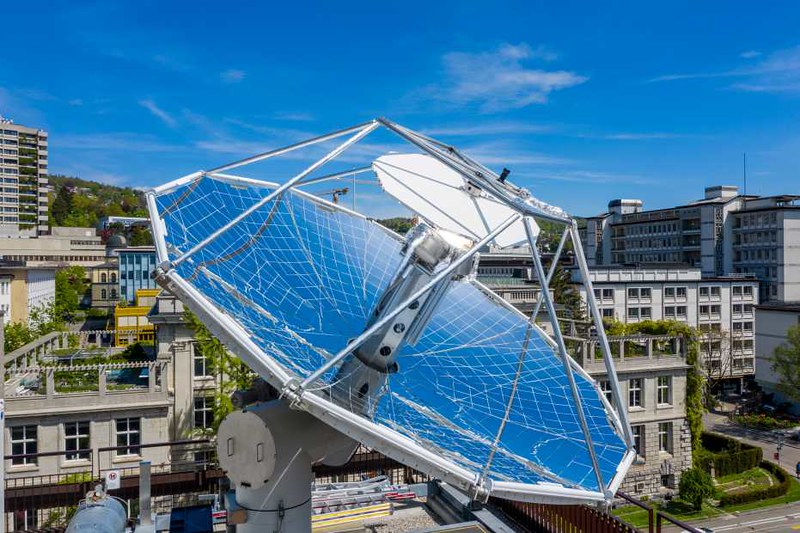https://e-info.org.tw/node/218826?utm_source=%E7%92%B0%E5%A2%83%E8%B3%87%E8%A8%8A%E9%9B%BB%E5%AD%90%E5%A0%B1&utm_campaign=d47803e714-EMAIL_CAMPAIGN_2019_06_03_03_57_COPY_02&utm_medium=email&utm_term=0_f99f939cdc-d47803e714-84956681
新技術 用日光、空氣合成的「碳中和」交通燃料誕生
環境資訊中心外電;姜唯 翻譯;林大利 審校;稿源:ENS
蘇黎世聯邦理工學院(Swiss Federal Institute of Technology Zurich, ETH Zurich)的研究人員開發出一種創新技術,僅用陽光和空氣就能生產液態烴燃料。
在蘇黎世ETH機械實驗室大樓屋頂的新型太陽能小型煉油廠中,科學家們全球首次展示真實現場條件下的完整熱化學流程。研究人員打造的這座太陽能發電廠能生產合成液體燃料,這些燃料在燃燒過程中釋放出的二氧化碳(CO2),和其原料空氣一樣多。

該製程直接從環境空氣中提取二氧化碳和水,用太陽能分解產生合成氣體,即氫氣和一氧化碳的混合物。合成氣體可以加工成煤油、甲醇或其他烴類。這些加入式燃料可以用於目前全球的運輸基礎設施。
負責開發此技術的團隊是ETH再生能源載具教授史坦菲爾德(Aldo Steinfeld)和他的研究小組。「這個電廠證實,碳中和(Carbon-neutral)的碳氫燃料,可以在真實的條件下由陽光和空氣製成」史坦菲爾德說,「熱化學過程利用整個太陽光譜並在高溫下進行,反應快、效率高。」
實驗結果顯示,這座設在ETH屋頂上的太陽能小型「煉油廠」,即使以蘇黎世的氣候條件,該技術也是可行的,每天可產生大約一公合的燃料。
在歐盟太陽能液體計畫(EU sun-to-liquid)架構下,史坦菲爾德和研究團隊正在馬德里附近的太陽能塔中,對他們的太陽能反應爐進行大規模測試。該太陽能發電廠也和蘇黎世的小型煉油廠同時於6月13日在馬德里公開展示。
這套新系統的流程鏈結合了三個熱化學轉化過程:
首先,從空氣中提取二氧化碳和水。第二,太陽能熱化學分解二氧化碳和水。第三,液化成碳氫化合物。
二氧化碳和水都是透過吸收/脫附過程直接從環境空氣中提取,接著在拋物面反射器的焦點處送入太陽能反應器。
太陽輻射能在焦點處聚集3,000倍,在太陽能反應爐內產生1,500°C的溫度。
太陽能反應爐的核心是由二氧化鈰製成的陶瓷結構,能夠進行兩步驟的氧化還原循環,將水和二氧化碳分解成合成氣,接著透過一般的甲醇或費托合成(Fischer–Tropsch process)將氫和一氧化碳混合物加工成液態烴燃料。
碳中和燃料是發展永續性航空和海上運輸的關鍵。
史坦菲爾德的研究已經衍生出兩間公司:2016年成立的Synhelion公司將太陽能燃料生產技術商業化;2010年成立的Climeworks公司將從空氣中捕獲二氧化碳的技術商業化。
下一個計畫的目標是擴大技術規模,使其具有經濟競爭力。「一個面積一平方公里的太陽能發電廠每天可生產20,000升煤油,」Synhelion公司董事兼技術長、曾是史坦菲爾德實驗室博士生的富勒(Philipp Furler)說。
「理論上,一座面積相當於整個瑞士或1/3個加州莫哈韋沙漠的電廠,就可以滿足整個航空業的煤油需求,」富勒說,「我們未來的目標是利用我們的技術高效生產永續燃料,減少全球二氧化碳排放。」
Carbon-neutral Fuel Created from Sunlight and Air
An innovative technology that produces liquid hydrocarbon fuels from only sunlight and air has been developed by researchers from the Swiss Federal Institute of Technology Zurich, known as ETH Zurich.
For the first time anywhere in the world, scientists have demonstrated the entire thermochemical process chain under real field conditions in a new solar mini-refinery located on the roof of ETH's Machine Laboratory building in Zurich.
ETH researchers have built a solar plant to produce synthetic liquid fuels that release as much carbon dioxide (CO2) during their combustion as previously extracted from the air for their production.
CO2 and water are extracted directly from ambient air and split using solar energy. This process yields syngas, a mixture of hydrogen and carbon monoxide, which can be processed into kerosene, methanol or other hydrocarbons. These drop-in fuels are ready for use in the existing global transport infrastructure.
Aldo Steinfeld, professor of renewable energy carriers at ETH Zurich, and his research group developed the technology.
"This plant proves that carbon-neutral hydrocarbon fuels can be made from sunlight and air under real field conditions," Steinfeld explained. "The thermochemical process utilizes the entire solar spectrum and proceeds at high temperatures, enabling fast reactions and high efficiency."
The solar mini-refinery on the roof of ETH Zurich proves that the technology is feasible, even under the climate conditions prevalent in Zurich. It produces around one decilitre of fuel per day.
Steinfeld and his group are already working on a large-scale test of their solar reactor in a solar tower near Madrid, which is carried out within the scope of the EU project sun-to-liquid. The solar power plant was presented to the public in Madrid at the same time on June 13 as the mini-refinery in Zurich.
The process chain of the new system combines three thermochemical conversion processes:
First, the extraction of CO2 and water from the air. Second, the solar-thermochemical splitting of CO2 and water.
Third, their subsequent liquefaction into hydrocarbons.
First, the extraction of CO2 and water from the air. Second, the solar-thermochemical splitting of CO2 and water.
Third, their subsequent liquefaction into hydrocarbons.
CO2 and water are extracted directly from ambient air via an adsorption/desorption process. Both are then fed into the solar reactor at the focus of a parabolic reflector.
Solar radiation is concentrated by a factor of 3,000, generating process heat at a temperature of 1,500 degrees Celsius inside the solar reactor.
At the heart of the solar reactor is a ceramic structure made of cerium oxide, which enables a two-step reaction, the redox cycle, to split water and CO2 into syngas. This mixture of hydrogen and carbon monoxide can then be processed into liquid hydrocarbon fuels through conventional methanol or Fischer–Tropsch synthesis.
Carbon-neutral fuels are the key to making aviation and maritime transport sustainable.
Two spin-offs have already emerged from Steinfeld's research group: Synhelion, founded in 2016, commercializes the solar fuel production technology. Climeworks, founded in 2010, commercializes the technology for CO2 capture from air.
The next project goal is to scale the technology for industrial implementation and make it economically competitive. "A solar plant spanning an area of one square kilometre could produce 20,000 litres of kerosene a day," said Philipp Furler, director and chief technical officer of Synhelion and a former doctoral student in Steinfeld's group.
"Theoretically, a plant the size of Switzerland, or a third of California's Mojave Desert, could cover the kerosene needs of the entire aviation industry," Furler said. "Our goal for the future is to efficiently produce sustainable fuels with our technology and thereby mitigate global CO2 emissions."
※ 全文及圖片詳見:ENS








沒有留言:
張貼留言